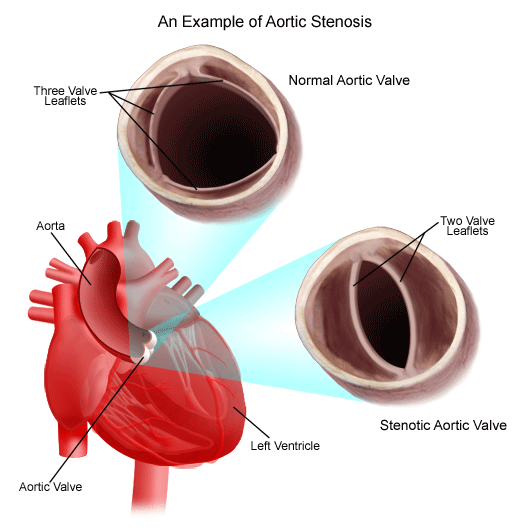That sucks pal..... Do you do aspirin to thin the blood and make it flow easier???? I hope so. Good luck Mr. and get all the help you can with this,,,,,,,,
Ans start eating more good stuff for your heart!!!!!
Aortic valve stenosis definition and facts
Aortic stenosis is narrowing of the aortic valve, impeding delivery of blood from the heart to the body.
Aortic stenosis can be caused by congenital bicuspid aortic valve, scarred aortic valve of rheumatic fever, and wearing of aortic valve in the elderly.
Aortic stenosis can cause chest pain, fainting, and heart failure leading to shortness of breath.
Echocardiogram and cardiac catheterization are important tests in diagnosing and evaluating severity of aortic stenosis.
Patients with aortic stenosis are usually given antibiotics prior to any procedures which might introduce bacteria into the bloodstream, such as dental procedures and surgeries.

Causes
As the aortic valve narrows, the left ventricle has to work harder to pump blood out through the valve. To do this extra work, the muscles in the ventricle walls become thicker. This can lead to chest pain.
As the pressure continues to rise, blood may back up into the lungs. Severe aortic stenosis can limit the amount of blood that reaches the brain and the rest of the body.
Aortic stenosis may be present from birth (congenital), but most often it develops later in life. Children with aortic stenosis may have other conditions present from birth.
Aortic stenosis mainly occurs due to the buildup of calcium deposits that narrow the valve. This is called calcific aortic stenosis. The problem mostly affects older people.
Calcium buildup of the valve happens sooner in people who are born with abnormal aortic or bicuspid valves. In rare cases, calcium buildup can develop more quickly when a person has received chest radiation (such as for cancer treatment).
Another cause is rheumatic fever. This condition can develop after strep throat or scarlet fever. Valve problems do not develop for 5 to 10 years or longer after rheumatic fever occurs. Rheumatic fever is becoming rarer in the United States.
Aortic stenosis occurs in about 2% of people over 65 years of age. It occurs more often in men than in women.
http://medlineplus.gov/ency/article/000178.htm

Realist - Everybody in America is soft, and hates conflict. The cure for this, both in politics and social life, is the same -- hardihood. Give them raw truth.
